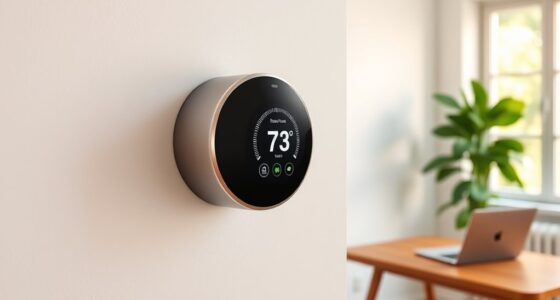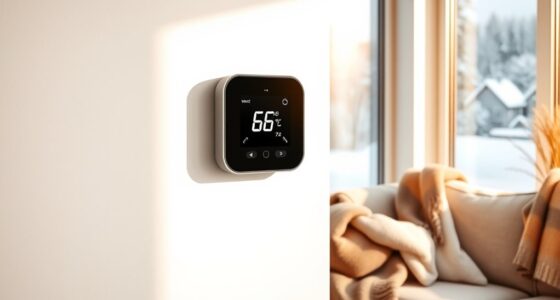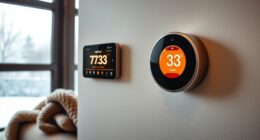To boost summer efficiency with your smart thermostat, set it higher during the hottest parts of the day when you’re away or asleep, typically around 78°F, and program custom schedules to automatically adjust the temperature based on your routines. Use features like occupancy sensing and adaptive scheduling to optimize cooling times, and control settings remotely when plans change. Continuing will reveal more tips to help you save energy while staying comfortable all season.
Key Takeaways
- Program your thermostat to increase temperatures by 5-8°F during peak heat hours to save energy.
- Use smart features like occupancy sensing and adaptive scheduling to optimize cooling times automatically.
- Maintain a comfortable 78°F during the day and use fans instead of lowering the thermostat further.
- Pre-cool your home before returning and control settings remotely to adapt to changing plans.
- Review energy reports and fine-tune schedules regularly for ongoing summer energy efficiency.

As summer arrives, adjusting your smart thermostat settings can considerably improve your home’s energy efficiency and keep your cooling costs in check. Summer heat can cause your energy bills to skyrocket if you’re not careful, but with a few strategic changes, you can stay comfortable while saving money. One of the most effective ways is to leverage your smart thermostat features. Modern smart thermostats come equipped with a variety of energy saving tips that help optimize your cooling schedule without sacrificing comfort. These features often include adaptive scheduling, occupancy sensing, and remote control, giving you the tools to fine-tune your home’s climate.
Start by setting your thermostat higher during the hottest parts of the day when you’re away or asleep. Many smart thermostats allow you to create custom schedules that automatically adjust the temperature based on your routines. For example, you might program your thermostat to increase the temperature by 5 to 8 degrees during work hours or when you’re out running errands. When you return home, it can cool down again, ensuring comfort without excessive energy use. This simple adjustment reduces the workload on your air conditioning system, which in turn cuts down on energy consumption and lowers your bills.
Adjust your thermostat higher during the day and program it to cool down when you return home for energy efficiency.
Utilize the occupancy sensing feature if your smart thermostat has one. These sensors detect whether anyone is home and adjust the temperature accordingly. When the house is empty, the thermostat can raise the temperature slightly to conserve energy, and then lower it when you arrive. This way, you’re not wasting energy cooling an unoccupied space. Additionally, some smart thermostats allow you to control settings remotely via a smartphone app, giving you the flexibility to make real-time adjustments if your plans change. For instance, if you’re coming home early, you can pre-cool your house, ensuring comfort without running the AC unnecessarily all day.
Another energy saving tip is to set your thermostat to a higher but comfortable temperature during the day, typically around 78°F (26°C). This is generally considered a good balance between comfort and efficiency. If you find that you need a bit cooler air, you can use fans to enhance comfort rather than lowering the thermostat excessively. Remember, every degree you raise the thermostat can save you around 3% on cooling costs, so small adjustments add up over time.
Finally, take advantage of your smart thermostat’s learning capabilities. Many models analyze your habits and suggest ideal settings to maximize energy savings. Regularly reviewing your energy reports can help you identify patterns and fine-tune your schedule further. By combining these energy saving tips with the smart features of your thermostat, you’ll be able to maintain a cool, comfortable home during summer while keeping energy costs under control.
Frequently Asked Questions
How Does Humidity Affect Smart Thermostat Settings in Summer?
Humidity impact affects your smart thermostat settings by making your home feel hotter or cooler than the actual temperature. When humidity is high, you might need to set your thermostat lower to maintain comfort. Conversely, lower humidity levels allow you to set a higher temperature without sacrificing comfort. Adjusting your thermostat based on humidity helps optimize energy use and keeps your home more comfortable during summer.
Can Smart Thermostats Learn My Preferred Summer Temperature Automatically?
Think of your smart thermostat as a weather vane that learns your summer comfort zone. It uses learning algorithms to automatically adjust to your temperature preferences over time. As you set your ideal temps, it observes patterns and fine-tunes itself, so you don’t have to. Soon, it’ll keep your home perfectly cool without you lifting a finger, making summer living effortlessly comfortable.
Are There Specific Settings for Different Rooms or Zones?
Yes, smart thermostats often support zoning strategies, allowing you to set room-specific adjustments. You can create different temperature settings for each zone or room, optimizing comfort and energy efficiency. By customizing these settings, you guarantee that each space maintains the desired temperature without wasting energy in unoccupied areas. This zoning approach helps you save on cooling costs while keeping every room comfortable during summer.
How Often Should I Adjust My Thermostat During Peak Heat?
Like tuning a vintage radio, you should adjust your thermostat as needed during peak heat, usually every few days or when outdoor temperatures change considerably. Keep your thermostat calibrated to guarantee ideal performance, especially during heat waves. When outdoor temps soar, lowering your thermostat slightly can improve comfort and efficiency. Regular adjustments help prevent overcooling and save energy, making your home a cool oasis amid the summer heat.
Do Smart Thermostats Help Reduce Energy Bills in Summer?
Yes, smart thermostats help reduce your energy bills in summer by optimizing cooling schedules and adjusting temperatures based on your habits. They enhance energy savings by learning your preferences, turning off when you’re away, and pre-cooling rooms efficiently. This automation leads to significant cost reduction over time. Using a smart thermostat makes it easier to maintain comfort while cutting down on unnecessary energy use, saving you money effortlessly.
Conclusion
By adjusting your smart thermostat for summer, you’re steering your home toward comfort and savings, like a captain guiding a ship smoothly through calm waters. With the right settings, you’ll enjoy a cool, energy-efficient environment without breaking the bank. Embrace the seasonal changes and let your thermostat work smarter, not harder. When you fine-tune your system, you’re not just saving money—you’re creating a breeze of comfort that flows effortlessly through your home all summer long.









